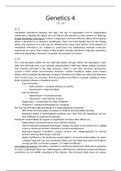Genetics 4
HC 16
4.1
Mendelian inheritance features two laws, the law of segregation and of independent
assortment, whereby the genes are not altered and passed on from parent to offspring.
Simple Mendelian inheritance involves a single gene, with two different alleles which display
either a dominant or a recessive relationship. There are traits though that do not display
either, the outcome of a trait may be influenced by many more factors. Such patterns of
Mendelian inheritance are studied to understand the relationship between molecular
expression of a gene, the function of the product and the trait itself; molecular expression
influences phenotype. Moreover, to predict the outcome of crosses.
4.2
The most prevalent alleles are the wild-type alleles, though within one population, more
than one wild-type may occur; genetic polymorphism. Wild-type alleles produce proteins
that function normally in the right amounts, which is why they promote reproductive
success in their native environments. However, random mutations might cause mutant
alleles, which probably disrupts gene function, therefore the alleles are said to be defective
and, in most cases, are recessive. They thus produce too little of a protein, leading to many
kinds of genetic diseases. Mutations can be:
- Loss-of-function:
o Null mutation = complete absence of activity
o Hypomorph = reduced activity
- Gain-of-function:
o Hypermorph = increased activity
o Neomorph = new function of gene
- Suppressors = compensate for other mutations
- Enhancers = enhances phenotype of a mutation.
But how can the wild-type phenotype of a heterozygote be explained?
- 50% of the normal protein is enough to continue normal cellular function
- Dominant alleles in heterozygotes produce more than 50% (up-regulation) and are
thus sufficient to continue functioning.
Dominant mutant alleles do appear in populations and have their effects via:
- Hypermorph: increased level or more effective activity
- Gain-of-function mutations/neomorph: changes the gene or the protein of it, adding
a new or abnormal function, whereby it can be overexpressed.
- Dominant-negative mutations: mutant protein acts antagonistically to normal
protein, whereby phenotype is altered.
- Haplo-insufficiency: the dominant mutant allele is a loss-of-function allele. So, when
a diploid organism has one inactivated allele and one allele that does not produce
enough product to function properly, it is haplo-insufficient.
Incomplete penetrance describes a situation in which the (dominant) allele that is expected
to cause a phenotype does not. Heterozygotes suffering from dominant autosomal diseases
sometimes do not exhibit symptoms of the disease; the dominant allele does not always





